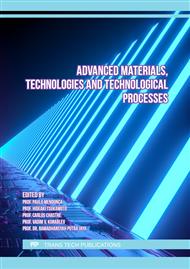[1]
C.G. Granqvist, Oxide electrochromics: An introduction to devices and materials, Sol. Energy Mater. Sol. Cells. 99 (2012) 1-13.
Google Scholar
[2]
A.G. Krynin, U.A. Khokhlov, V.A. Bogatov, P.P. Kislyakov, Transparent interfrence coating for functional glass materials, Proc. VIAM. 11 (2013) 5. Available: https://www.elibrary.ru/download/elibrary_21013194_76732003.pdf.
Google Scholar
[3]
M. Kovalev, A. Shakhmatov, A. Alhimenko, Electrochemical studies of welded joints corrosion resistance made from stainless steels, Mater. Today Proc. 30 (2020) 501–505.
DOI: 10.1016/j.matpr.2020.01.034
Google Scholar
[4]
P.-W. Chen, C.-T. Chang, M.M. Ali, J.-Y. Wu, Y.-C. Li, M.H. Chen, Tantalum oxide film deposited by vacuum cathodic arc plasma with improved electrochromic performance, Sol. Energy Mater. Sol. Cells. 182 (2018) 188–195.
DOI: 10.1016/j.solmat.2018.02.034
Google Scholar
[5]
G.T. Phan, D.V. Pham, R.A. Patil, C.H. Tsai, C.C. Lai, W.C. Yeh, Fast-switching electrochromic smart windows based on NiO-nanorods counter electrode, Sol. Energy Mater. Sol. Cells. 231 (2021) 111306.
DOI: 10.1016/j.solmat.2021.111306
Google Scholar
[6]
M. Kovalev, E. Alekseeva, N. Shaposhnikov, A. Povyshev, Predicting the durability of zinc coatings based on laboratory and field tests, E3S Web Conf. 121 (2019) 01008.
DOI: 10.1051/e3sconf/201912101008
Google Scholar
[7]
O. Shvetsov, S. Kondrat'ev, Performance of Protective Coatings for Aluminum Alloys in the Operating Conditions of Oil Production Equipment, E3S Web Conf. 225 (2021) 05003.
DOI: 10.1051/e3sconf/202122505003
Google Scholar
[8]
D. Ma, G. Shi, H. Wang, Q. Zhang, Y. Li, Hierarchical NiO microflake films with high coloration efficiency, cyclic stability and low power consumption for applications in a complementary electrochromic device, Nanoscale. 5(11) (2013) 4808–4815.
DOI: 10.1039/c3nr00887h
Google Scholar
[9]
A.S. Kondrateva, S. E. Alexandrov, Fundamental physicochemical regularities of the chemical vapor deposition of nickel oxide layers, Russ. J. Appl. Chem. 89(9) (2016) 1402–1408.
DOI: 10.1134/s1070427216090032
Google Scholar
[10]
Y. Ito, Y. Abe, M. Kawamura, K. H. Kim, T. Kiba, Influence of substrate cooling on ion conductivity of tantalum oxide thin films prepared by reactive sputtering using water vapor injection, Thin Solid Films. 710 (2020) 138276.
DOI: 10.1016/j.tsf.2020.138276
Google Scholar
[11]
E.I. Gol'dman, A.G. Zhdan, A.M. Sumaroka, D. Parsons, Franz-Keldysh effect in the electric fields of macroscopic irregularities at a semiconductor surface, JETP Lett. 57(12) (1993) 797–801.
Google Scholar
[12]
J. Li, A. Takeuchi, M. Ozawa, X. Li, K. Saigo, K. Kitazawa, C60 fullerol formation catalysed by quaternary ammonium hydroxides, J. Chem. Soc. Chem. Commun. 23 (1993) 1784.
DOI: 10.1039/c39930001784
Google Scholar
[13]
D.G. Letenko, V.A. Nikitin, K.N. Semenov, N.A. Charykov, A.S. Ivanov, Conductivity of aqueous solutions of fullerol synthesized by direct oxidation, Russ. J. Phys. Chem. A. 86(12) (2012) 1808-1815.
DOI: 10.1134/s003602441212014x
Google Scholar
[14]
K.N. Semenov, D.G. Letenko, N.A. Charykov, V.A. Nikitin, Synthesis and identification of fullerenol prepared by the direct oxidation route, Russ. J. Appl. Chem. 83(12) (2010) 2076–2080. DOI:10.1134/ S1070427210120025.
DOI: 10.1134/s1070427210120025
Google Scholar
[15]
A. Karasev, E. Alekseeva, A. Lukianov, P.G. Jönsson, Characterization of non-metallic inclusions in corrosion-resistance nickel-based EP718 and 718 alloys by using electrolytic extraction method, E3S Web Conf. 121 (2019) 04004.
DOI: 10.1051/e3sconf/201912104004
Google Scholar


